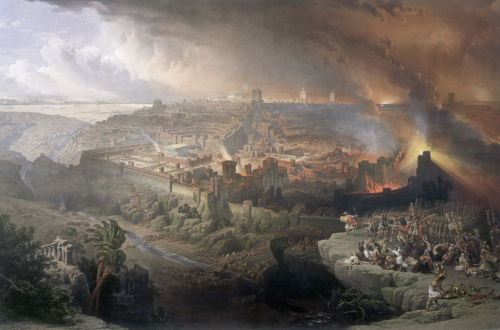The most popular modern hypothesis for explaining the publication order of the Synoptic Gospel is that Mark was published first, followed by Matthew and Luke, each having used Mark and other sources without having consulted each other. Variations exist on this hypothesis; but consistently, Mark is claimed to have been the first published, some thirty or so years after the resurrection, give or take a decade. My recent efforts have largely been focused on challenging this hypothesis, relative to the dates of the earliest Gospels and their publication order—I contend that Matthew was published within a decade of the resurrection and Mark shortly thereafter, followed later by Luke (and John).
Alternatively, advocates of the Two-Gospel (or Griesbach) hypothesis theorize that there was a Matthew-Luke-Mark publication order. Some advocates argue for an early Greek publication of Matthew (e.g., Black),1 or at least an early limited-scope Hebrew version of Matthew (e.g., Riley),2 while other advocates allow for later dates for all of the Gospels. One of the supporting arguments for the Two-Gospel hypothesis observes that Mark appears to combine descriptive material found in both Matthew and Luke. For example, after Jesus had healed Simon Peter’s mother-in-law, Matthew says, “that evening they brought to him many who were oppressed by demons and he cast out the spirits” (Matt. 8:16). Whereas, Luke transitions with “now when the sun was setting” (Mark 4:40). In contrast. Mark’s transition includes elements found in both Matthew and Luke: “that evening at sundown” (Mark 1:32). For Two-Gospel advocates, this is evidence that Mark is using Matthew and Luke as sources.
More difficult to accept, from their perspective, is the possibility that Matthew and Luke have independently “used Mark and generally simplified his more wordy text,” as is suggested by the popular hypothesis that Mark was published first.3
While I concur that this behavior concerning the “descriptive material” is a solid argument against the popular hypothesis of Markan priority (i.e., that Mark was published first), I suggest that a Matthew-Mark-Luke publication order is also a viable alternative for rationalizing the behavior. We will touch on that later.
First however, let’s review several examples from the Two-Gospel perspective, where Mark offers a description which appears to incorporate elements from both Matthew and Luke. For this, we leverage a subset of the examples in Harold Riley’s The Making of Mark, appendix 2, “Duality in Mark.”4 Note, in the table below, Mark’s apparent use of material from both Matthew (in bold) and Luke (in italics).
| Matthew | Luke | Mark |
| 4:1–3. Then Jesus was led up by the Spirit into the wilderness to be tempted by the devil. And after fasting forty days and forty nights, he was hungry. And the tempter came … (ESV) | 4:1–2. And Jesus, full of the Holy Spirit, returned from the Jordan and was led by the Spirit in the wilderness for forty days, being tempted by the devil. And he ate nothing during those days. And when they were ended, he was hungry. | 1:12-13. The Spirit immediately drove him out into the wilderness. And he was in the wilderness forty days, being tempted by Satan. … |
| 8:16. That evening … | 4:40. Now when the sun was setting ..… | 1:32. That evening at sundown |
| 8:3. … And immediately his leprosy was cleansed. … | 5:13. … And immediately the leprosy left him. | 1:42. And immediately the leprosy left him, and he was made clean. |
| 9:3. And behold, some of the scribes said to themselves, “This man is blaspheming.” | 5:21. And the scribes and the Pharisees began to question, saying, “Who is this who speaks blasphemies? Who can forgive sins but God alone?” | 2:7. “Why does this man speak like that? He is blaspheming! Who can forgive sins but God alone?” |
| 5:15. Nor do people light a lamp and put it under a basket, but on a stand, and it gives light to all in the house. | 8:16. “No one after lighting a lamp covers it with a jar or puts it under a bed, but puts it on a stand, so that those who enter may see the light. | 4:21. And he said to them, “Is a lamp brought in to be put under a basket, or under a bed, and not on a stand? |
| 8:28. … two demon-possessed men met him, coming out of the tombs, so fierce that no one could pass that way. | 8:27. … there met him a man from the city who had demons. For a long time he had worn no clothes, and he had not lived in a house but among the tombs. | 5:2, 3. And when Jesus had stepped out of the boat, immediately there met him out of the tombs a man with an unclean spirit. He lived among the tombs. And no one could bind him anymore, not even with a chain, |
| 8:31. … “If you cast us out, send us away into the herd of pigs.” | 8:32. … they begged him to let them enter these. … | 5:12. and they begged him, saying, “Send us to the pigs; let us enter them.” |
| 8:33. 33 The herdsmen fled, and going into the city they told everything, especially what had happened to the demon-possessed men. | 8:35. Then people went out to see what had happened, and they came to Jesus and found the man from whom the demons had gone, … | 5:15. And they came to Jesus and saw the demon-possessed man, the one who had had the legion … |
| 19:29. … for my name’s sake … | 18:29. … for the sake of the kingdom of God, | 10:29. … for my sake and for the gospel, |
| 20:29. And as they went out of Jericho, a great crowd followed him. | 18:35. As he drew near to Jericho, a blind man was sitting by the roadside begging. | 10:46. And they came to Jericho. And as he was leaving Jericho with his disciples and a great crowd, Bartimaeus, a blind beggar, the son of Timaeus, was sitting by the roadside. |
| 27:57. When it was evening, there came a rich man from Arimathea, named Joseph, who also was a disciple of Jesus. | 23:54. It was the day of Preparation, and the Sabbath was beginning. | 15:42. And when evening had come, since it was the day of Preparation, that is, the day before the Sabbath, |
The pattern should be evident (and Riley offers many more examples)—Matthew and Luke have different descriptions of whatever, while Mark’s descriptions incorporate material found in both Matthew and Luke.
Is there a way to explain this behavior, from the perspective of a Matthew-Mark-Luke publication order? Yes, because the church fathers tell us that Mark reflects the public teaching of Peter5 to a Roman audience;6 accordingly, Peter’s teaching can be assumed to be more verbose and descriptive than what Matthew conveyed to his Jewish audience, who would be familiar with the cultural framework of Jesus’ ministry. Then, some years after both Matthew and Mark had been published, one can envision the author of Luke desiring to tighten up the material for his Greco-Roman audience and thus skipping over the wording from Mark which had originated in Matthew’s text.
This speculation does not rise to the level of proof; however, it offers a reasonable alternative explanation for what otherwise appears to the Two-Gospel advocates as conflation.
- David Alan Black, Why Four Gospels?: The Historical Origins of the Gospels, 2nd ed. (Gonzalez, FL: Energion, 2010). ↩︎
- Harold Riley, The Making of Mark: An Exploration (Macon, GA: Mercer University Press, 1989), 246. ↩︎
- Ibid., 219. ↩︎
- Ibid., 219-227. ↩︎
- Irenaeus, Against Heresies 3.1.1. ↩︎
- Eusebius cites Clement in Eusebius, Ecclesiastical History 6.14.5–7. Clement is cited with the understanding that Rome refers to Rome, the empire, as I have articulated elsewhere. ↩︎
NOTE: Comments and dialog are welcome. The “Leave a Reply” field will be accessible below for 10 days after this post was published. Afterwards, please feel free to continue to comment via the contact page. (This is my attempt to manage the spam bots.)





